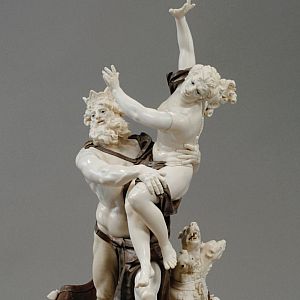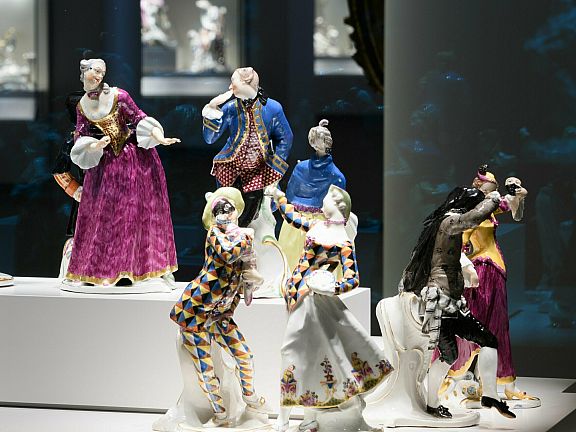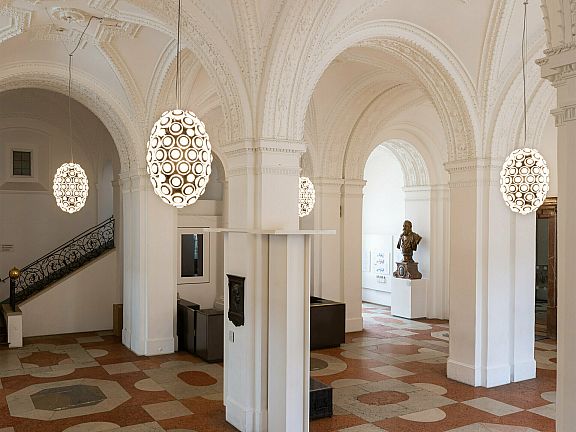Search
…Bavarian and Palatine Wittelsbach rulers were among the great patrons of the arts in the Baroque era. The Bayerisches Nationalmuseum presents unique objects from the leading…
The Bayerisches Nationalmuseum´s collection of European Baroque ivories. German guided tour. Turned objects, statuettes and reliefs – belongs to the most comprehensive and…
German guided tour. The Bayerisches Nationalmuseum´s collection of European Baroque ivories - turned objects, statuettes and reliefs – belongs to the most comprehensive and…
German guided workshop for kids from the age of 9. Registration necessary. Sponserd by Reuschel-Stiftung
The globes of the Venetian scholar Vincenzo Coronelli were famous for their magnificent imagery and were also known to document the latest geographical discoveries. At the time,…
In the Baroque period, gaming tables were among the most important pieces of furniture in palaces and residences, as social games and gambling were an essential part of courtly…
Since the 17th century, the Roemer is considered the most popular type of wine glass in Central and Northern Europe. Characteristic features of this glass are a conical foot, a…
In the 18th century, nativity scenes were almost exclusively exhibited publicly in churches and convents. In this nativity scene by the Servite Order, a Catholic Order committed…
The beautiful young woman lies asleep on a luxurious chaise longue. The furniture and the fashionable outfit only seem to contradict the depiction as a shepherdess. In the Rococo…
This monumental showpiece cabinet with two writing compartments with fold-down desk tops on each side, revolving tabernacle with drawers in the middle and a top piece with clock…
This rifle is one of the most beautiful weapons produced by German gunsmiths in the 18th century. Extremely fine reliefs with hunting scenes and Rococo ornamentation adorn the…
The little porcelain box mounted in pure gold containing a perfume set is one of the most exquisite products of Viennese Du Paquier Porcelain Factory. It originally came from the…
During the 18th century, people throughout Europe liked to dress according to French fashion and also preferred using French terms. Richly embroidered men's suits of silk fabric…
The court society is gathered in front of the summer palace of the prince-bishops of Freising at Ismaning. While the table is being laid and the guests play cards at one of the…
The two-door cabinet is painted with depictions of the four seasons. In the lower half of the left door, a Latin inscription informs us that it was made in Elbach and painted in…
Most Neapolitan nativity scenes do not put the main focus on the sacred events, rather they are colourful renderings of the lively hustle and bustle of the southern Italian city.…
Coming from a large family of sculptors, Franz Xaver Messerschmidt started his career at the Viennese court of Empress Maria Theresa. He fell ill and was forced to leave Vienna in…
David Roentgen was the most famous German cabinetmaker of the 18th century. His Neuwied furniture factory supplied all European courts between Paris, Berlin and St Petersburg.…
In Europe the mystery behind making porcelain was only unveiled around 1707/08 in Meissen. It was called the Arcanum and was closely guarded secret. This case is a unique document…
This monumental monstrance is one of the greatest masterpieces of Baroque silversmithing in Munich. Franz Kessler, goldsmith at the court of the Bavarian Elector Ferdinand Maria,…
The monumental lidded goblet is one of the major works of Baroque glass art. It was executed for August the Strong, King of Poland and Elector of Saxony. The huge, five-litre…
…physical assumption of Mary into heaven, one of the most common religious themes of the Baroque period. Johann Christian Thomas Wink submitted this Assumption of the Virgin for…
In his "Italian Journey" of 1787, Johann Wolfgang von Goethe also described the placement of nativity scenes in Naples during the Christmas season. He noticed that the Neapolitans…
This imposing grille was once part of the baroque decoration of the gothic Dominican church St Blaise in Regensburg. Richly decorated with foliage and strapwork, the gates and…
Many of the precious porcelains at the Bayerisches Nationalmuseum originally came from the Wittelsbach court and can be traced back to the 18th century. Due to their family…
This goblet is one of the largest and most virtuosic pieces of Baroque ivory turning and illustrates the high standards of the Electoral Collection in Düsseldorf. Georg Steiner,…
The sixteen comedy figures by the Nymphenburg modeller Franz Anton Bustelli are among the most beautiful porcelain figurines of the Rococo period. The highly gracefully composed…
This monumental tall-case clock once furnished a room in the Cistercian Abbey of Salem at Lake Constance. The complex but concealed clockwork by the Viennese Augustinian priest…
Canopy beds were a customary bridal accessory in rural areas in the 18th and 19th centuries. The ornamental painting on this bed is a reference to this occasion. The side boards…
In the 19th century, family-run and small businesses specialising in figurative reverse glass painting settled around glassworks in numerous places throughout Bavaria. The mostly…
This loosely-falling dress was tailored around 1740 and was later refashioned into a robe à la française with a fitted top around 1775. What makes this gown special is the use of…
Made to look like a garden pavilion, this faithfully preserved cabinet originally stood in the magnificent palace of Count Rheinstein-Tattenbach, which was located on…
Blue-glazed jugs were considered pure luxury in the 17th and 18th centuries, especially in rural Bavarian households, and only the wealthiest farmers and officials could afford…
As late as the 18th century, courts of justice would impose public shaming as punishment for minor offenses. The aim was to deter others by publicly disgrace the condemned. One…
…valuable gifts from the Florentine court, which later made their way from Düsseldorf to Munich and are now highlights of the collection of European Baroque sculpture.
Commissioned by Elector Max Emanuel, this monumental timepiece exemplifies the collaborative work of Augsburg craftsmen. The carpenter Heinrich Eichler is considered to be the…
In the 18th century, childbirth was fraught with danger and the risk of mortality was high for both the mother and the new-born child. Accordingly, parents were grateful when a…
Programmable lathes for the mechanical processing of the precious material ivory are among the most sophisticated pieces of equipment in the history of pre-industrial technology.…
Hunting was the privilege and passion of the nobility. This precious wheellock gun is one of the characteristic achievements of the Munich court workshops, where cutting and…
Nearly life-size, this porcelain bust is an intimate portrait of Count Sigmund von Haimhausen (1708-1793). He was the founding president of the Bavarian Academy of Sciences, chief…
The only complete crèche characterising the liturgical year in the Bayerisches Nationalmuseum's collection comes from the workshop of Augustin Alois and Josef Benedikt Probst.…
The hand-washing ceremony with jug and basin was a privilege of the highest-ranking person at the princely table. In keeping with the importance of this ceremonial act, lavabo…
According to Greek mythology, the Titan Cronus devoured his children because he feared to be overthrown by them. Only his son Zeus escaped this fate. Early on, he was equated with…
Symbolising the white and blue heraldic colours of Bavaria, ivory and lapis lazuli - the most precious materials imaginable - were used for the cabinet's palatial interior front…
Ignaz Günther executed four side altars and a pulpit for the church of the Hospital of the Merciful Brothers in Munich. The church was demolished at the beginning of the 19th…
Trompe l'oeil dishes were real eye-catchers on the courtly dining table. These dishes in the form of animals, vegetables or fruit were modelled deceptively real in faience or…
Traditionally, falconry was considered to be the most noble form of hunting and was therefore the exclusive preserve of princes. Peter Candid's painting shows in detail the…
This bottle is the oldest known brandy container made of wood in Germany. In the 17th century, spirits had finally gained acceptance as a means of enjoyment. Drinking games…
The tapestry shows a zebra being attacked by a leopard in a river landscape, surrounded by other exotic animals and plants. The tapestry has a surprising wealth of colourful and…
The ensemble is one of the most famous 'Bauernstuben' (peasant rooms) in German museums. These are furniture and fittings from a carpenter's household, which could be presented to…



















































